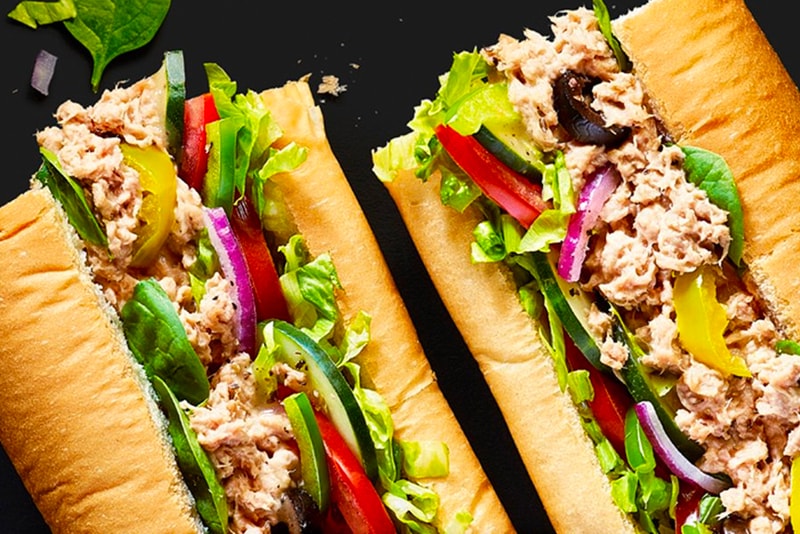Recently, a lawsuit has been filed against Subway claiming that their tuna sandwiches do not actually contain any tuna. Instead, the lawsuit alleges that the tuna is actually a “blend of various concoctions” that do not meet the standards of what is considered tuna. This revelation has sparked outrage among customers who have long believed they were consuming a healthy and sustainable seafood option.
The lawsuit further accuses Subway of false advertising and deceptive marketing practices, as they have been promoting their tuna sandwiches as containing real tuna when, in fact, they may not. This news has raised concerns about the transparency and integrity of Subway’s ingredients and has left many consumers questioning the authenticity of the products they are purchasing. Subway has yet to respond to these claims, leaving many customers wondering about the truth behind their favorite sandwich chain.

Ingredients Under Scrutiny: What’s Really in Subway’s Tuna
Recently, Subway has come under scrutiny for the ingredients used in their tuna sandwiches. Many customers and food critics have raised concerns about the actual contents of Subway’s tuna and whether it truly contains real fish. Some investigations have revealed that the tuna used by Subway may not be 100% tuna, as advertised. Instead, it is suspected that there may be other fillers or preservatives added to the tuna mixture.
This has led to questions about the quality and authenticity of Subway’s tuna sandwiches. Consumers are now questioning the transparency of Subway’s ingredients and are demanding more information about what they are actually consuming. With the rise of health-conscious consumers, there is a growing demand for restaurants to be more transparent about the ingredients used in their products.
Subway may need to address these concerns and provide more detailed information about the sourcing and processing of their tuna in order to regain the trust of their customers. It is essential for food companies to prioritize transparency and honesty in their ingredient sourcing and preparation methods in order to maintain a loyal customer base. Only time will tell how Subway will respond to these allegations and whether they will make any changes to their tuna sandwiches in light of this scrutiny.
Consumer Reactions: How the Lawsuit Is Affecting Subway’s Customer Base
The recent lawsuit against Subway has sparked mixed reactions among consumers, leading to a shift in the fast food chain’s customer base. Some patrons remain loyal to the brand, citing their long-standing enjoyment of Subway’s sandwiches and affordable prices. However, others have expressed concerns about the allegations raised in the lawsuit, causing them to question the quality and integrity of the ingredients used in Subway’s products.
This uncertainty has led some customers to seek alternatives, such as other fast food chains or healthier dining options. As a result, Subway may see a decline in sales as these dissatisfied customers take their business elsewhere. It is clear that the lawsuit has had a significant impact on Subway’s reputation and consumer trust, making it crucial for the company to address these concerns and regain the confidence of its customer base. Only time will tell how Subway will be able to navigate these challenges and rebuild its relationship with its patrons.
/cloudfront-us-east-1.images.arcpublishing.com/pmn/YZHU7UKWB5GM7MGWSOGBXMS4MU.jpg)
Behind the Scenes: The Process of Making Subway’s Tuna
The process of making Subway’s tuna salad begins with carefully selecting high-quality tuna that is sustainably sourced. Once the tuna is delivered to the processing facility, it is meticulously inspected for freshness and quality. The tuna is then minced and mixed with a proprietary blend of mayonnaise and seasonings to create the signature creamy texture and flavor that Subway is known for.
The mixture is then refrigerated to allow the flavors to meld together before being portioned out for distribution to Subway restaurants nationwide. Throughout the entire process, strict quality control measures are in place to ensure that only the best ingredients are used and that the final product meets Subway’s high standards. From start to finish, the process of making Subway’s tuna salad is a carefully orchestrated and monitored operation to ensure that customers receive a delicious and consistent product every time they order it.

Expert Opinions: Insights from Food Scientists on the Tuna Controversy
Food scientists have provided valuable insights on the ongoing tuna controversy, shedding light on the potential health risks associated with consuming certain varieties of tuna. Through their expertise, they have highlighted the importance of understanding the potential presence of harmful contaminants such as mercury in tuna fish. These experts have emphasized the need for consumers to be aware of the different types of tuna available on the market and the varying levels of mercury they may contain. By understanding the potential risks associated with consuming high-mercury tuna, individuals can make more informed decisions about their seafood choices.
Additionally, food scientists have also underscored the importance of sustainable fishing practices to ensure the long-term health of tuna populations and the ocean ecosystem as a whole. Through their research and knowledge, these experts have provided valuable information to help consumers navigate the complex world of tuna consumption and make choices that prioritize both their health and the health of the environment. Ultimately, their insights serve as a crucial resource for individuals seeking to make informed decisions about the tuna they consume, fostering a greater understanding of the complexities surrounding this controversial issue.
